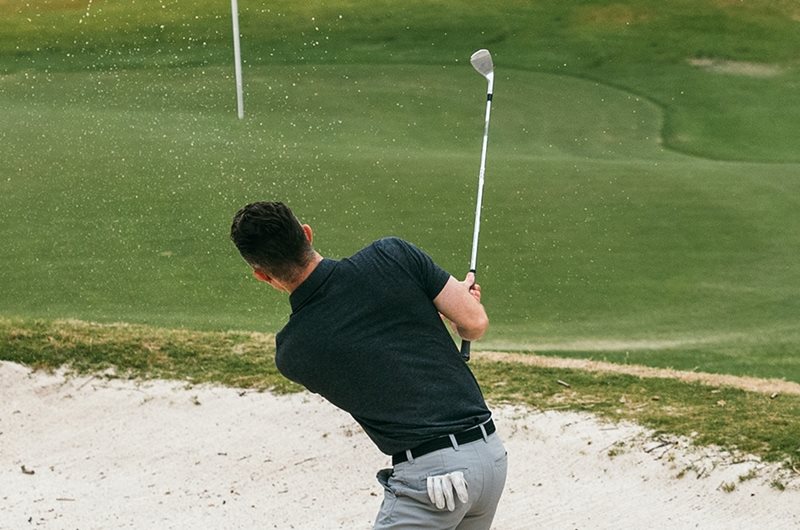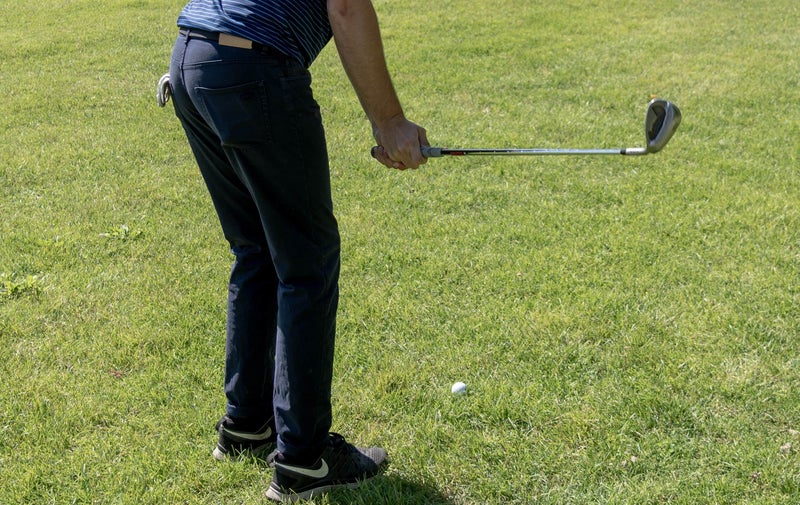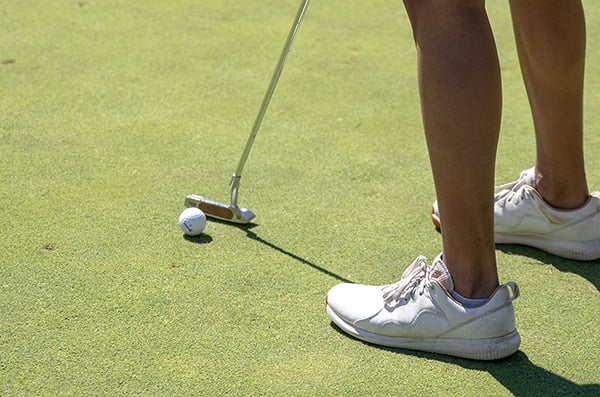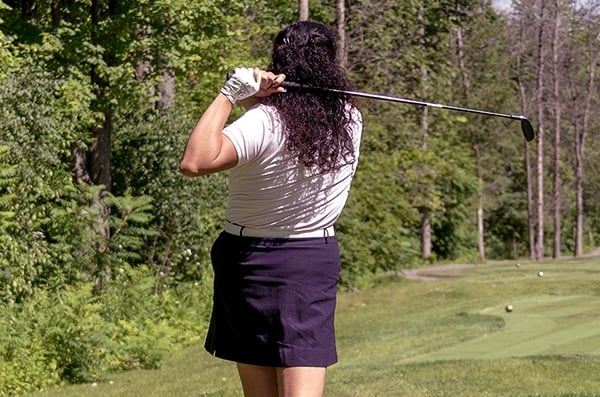-
{{link.label}}{{link.label}}
5 Simple Wedge Tips for Beginners
On this page
Your short game with your wedges can help you scramble and save pars even if the rest of your skills are not up to par on that day. However, having a bad short game with your wedges can lead to an inflated scorecard and will make it very difficult for you to get your golf ball on the green.

Having a strong short game doesn’t mean that you’ll be able to tuck the ball in within 20 feet of the pin just like the pros. Instead, for beginners and less experienced golfers, you’re only goal should be to get the ball safely on the green with your wedges. For golfers looking for help, we’ve got you covered!
Here’s what will be covered in this guide:
- 5 easy tips to help beginners and golfers of all levels hit their wedges better
- How to handle different situations on the course with your wedges
- How to implement these tips in your on-course performance
1. More loft angle in the club face of your wedge isn’t always better

Most beginners and less experienced golfers will take after the pros they watch on TV every week. When it comes to wedges, they’ll want to emulate the high arching wedge shots that pros are known for.
Pros send the ball flying high in the air because they manage to produce so much speed with their swing. Less experienced golfers can’t generate as much speed with their swing, so they resort to other solutions like more loft on their clubface.
This does technically make sense since the higher loft angle will naturally project the ball higher in the air. But using a higher loft angle will usually make the game more difficult for less experienced golfers as these high lofted clubs, still require some spin to be effective.
If you’re still new to the sport or having confidence issues with your wedges, take a club with a higher loft and try to bump and run the ball into the green. This is a much more efficient strategy for new golfers.
How to use the right loft angle for the bump and run technique:
- Take a club with a little less loft and try to use the bump and run technique where you hit the ball on a short distance, and you let it roll as close to the hole as possible. Unless you have a lot of distance to cover through the air, this technique should always be your go-to!
2. Swing through the golf ball with your wedges

Did you know that the best way to create a lot of spin on your golf ball at impact is to have it run across as many grooves as possible on the clubface? Your swing speed does play a role in creating spin, but your grooves are even more crucial to your wedges.
Many beginners tend to stop their swing motion at the ball to emulate the pros and their ability to magically stop the ball on the green with their wedges. Truth is the pros never stop their swing at the ball.
They might stop their swing shorter than what they normally would, but that is simply because they’re looking to hold their finish at a lower angle. Make no mistake, however, they never stop their swing at the ball when they hit their wedges.
Stopping your swing at the ball can produce awkward ball trajectories that might not suit your needs. Following through with your wedge swing after the impact will allow you to place the ball in a better position.
How to swing through the ball with your wedges:
- Try to keep your hands low in your follow-through when you’re hitting chip shots that need to spin and stop.
- Clear your hands and your club past your lead hip before stopping your swing to guarantee a complete follow-through.
3. Ball placement on your wedge shots

The placement of the ball on your wedge shots also plays a key role in the outcome of your strike. Placing the ball where you would normally set it for a fairway wood will result in a long-running wedge strike that will roll on the green once it touches down.
Most pros will recommend you place the ball closer to your trail foot, even going as far as placing it in line with the big toe of that same foot. They suggest you do so because it’s the best way to generate a lot of spin on the golf ball.
Placing the ball near your back foot is your best chance to compress the ball and send it flying while also generating enough spin so that it halts its forward progression and spins back on the green thus maximizing your wedge distance control.
This new ball placement will certainly not feel natural to beginners, but it’s the most efficient way to generate a lot of spin at impact when you hit your wedges.
How you should place your ball on wedge swings:
- Place it closer to your trail foot if you’re looking to generate a high spin rate on your wedge strike. This is particularly useful on chip shots and longer wedge strikes.
- Place it closer to your lead foot if you’re looking to roll the ball closer to the hole with your wedge once it touches the ground.
4. Utilize the bounce of your wedges to your advantage

Do you know what the bounce is on your wedges? Make sure to check out Golf Avenue’s guide to learn what bounces are and how critical they are to your wedge game.
As a quick recap, the bounce of your wedge is the degrees of separation between the ground and the leading edge of your wedge if you were to set it on its sole on a flat surface.
The degree of bounce will also vary from one wedge to the next, and this is most likely true for your set as well. You’ll want at least one wedge with a low bounce to negotiate tight lies on short distances. You’ll also want a wedge with a higher bounce degree for sand shots and softer courses.
A high degree of bounce will usually be 12 degrees or more, the medium bounce ranges from 11 to 9 degrees, and anything with a lower bounce is generally considered in the low bounce range.
How to utilize the bounce with your wedge:
- You need to drive your wedge into the ground at impact for the bounce to truly show its efficiency. If you use it properly, the club will bounce off both the ground and the ball at impact.
- With low bounce wedges, you need to clip the ball cleanly at impact. A heavy strike can be very costly with those wedges.
- With high bounce wedges, you benefit from a little window for error if you struggle with hitting your ball cleanly with your wedges.
5. Learn how to hit the different wedge shots

On top of allowing for short-distance shots, opening or closing the face of your wedges leaves a ton of room for creativity when you’re close to the green. Learning how to hit all the wedges shots can do wonders for your wedge play.
We’ve already touched upon the benefits of adding the bump and run to your arsenal. It’s a technique liked by many golfers especially beginners who prefer it to other high-flying alternatives.
Still, you should learn as many techniques as possible so that you can practice these different wedges shots when you visit the practice range. After enough practice, you might even be able to add them to your bag of tricks on the golf course.
What are the different types of wedge shots?
- The bump and run can be executed with almost any single golf club, but if you’re looking for a short roll of the ball, a wedge will be your best bet.
- The chip shot is a low-flighted wedge strike that is intended to cover a short distance on the green. A well-executed chip shop will bite into the green and stop moving on its first or second touch of the ground.
- The pitch shot is a longer wedge shot that will tend to feature a higher ball flight. These wedge shots are not full strikes and are struck to get the ball to spin quickly on the green and to stop as close to the target as possible.
- The flop shot is the flashy high-flying wedge shot that Phil Mickelson is so famous for. Hitting a flop demands not only a lot of practice but also demands a good amount of swing speed and an almost perfect swing.
Hopefully, this guide allows you to dial in your wedge game and helps you cut down on the number of strokes you’ll to be efficient around the greens. Mastering one shot type is great but being able to hit all wedge shots consistently will come in even more handy on the golf course.
If your wedges game isn’t too bad as of late but other parts of your game are suffering, be sure to check out our series of easy golf tips for beginners. You’ll be able to fix any issues you’ve had with your driver off the tee, learn useful fairway wood tips, and sink more birdies than ever with insightful putter tips.
Until next time,
The Golf Avenue team
Further reading
Looking for a better putting technique for beginners? Here’s 5 tips to help you learn how to constantly hit short putts and keep a low scorecard on the green!
Looking for how to consistently hit a fairway wood? Here are 5 beginner tips for your ball positioning, loft angle, tee-based shot, ground shot and stance!
Need help on how to hit a golf driver? Here’s 5 easy tips to guide you on your swing stance, grip, posture and choosing a driver to give you consistent hits.




